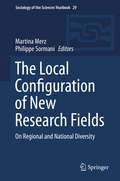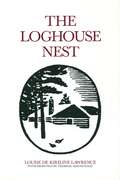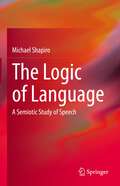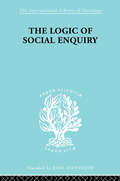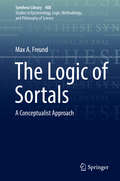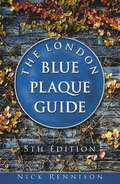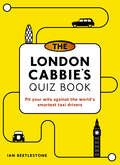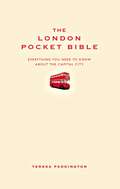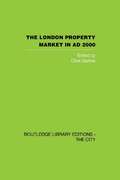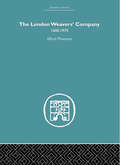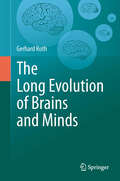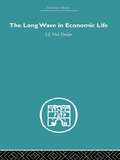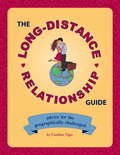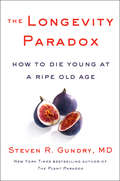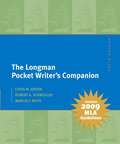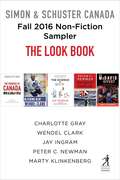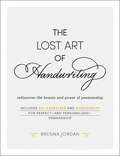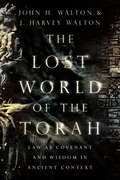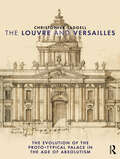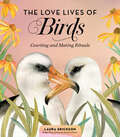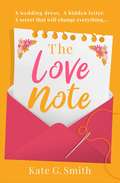- Table View
- List View
The Local Configuration of New Research Fields
by Martina Merz Philippe SormaniThis new Yearbook addresses the question of how policy, place, and organization are made to matter for a new research field to emerge. Bringing together leading historians, sociologists, and organizational researchers on science and technology, the volume answers this question by offering in-depth case studies and comparative perspectives on multiple research fields in their nascent stage, including molecular biology and materials science, nanotechnology, and synthetic biology. The Yearbook brings to bear the lessons of constructivist ethnography and the "practice turn" in Science and Technology Studies (STS) more broadly on the qualitative, comparative, and critical inquiry of new research fields. In doing so, it offers unprecedented insights into the complex interplay of national research policies, regional clusters, particular research institutions, and novel research practices in and for any emerging field of (techno-)science. It systematically investigates national and regional differences, including the variable mobilization of such differences, and probes them for organizational topicality and policy relevance.
The Loghouse Nest
by Louise De LawrenceA charming account of the author’s special relationship with the birds and wild creatures who shared her northern homesite at Pimisi Bay, near Mattawa, Ontario. The Loghouse Nest is another Natural Heritage classic by Canada’s internationally acclaimed nature writer, Louise de Kiriline Lawrence. Delightfully illustrated throughout by no less than Thoreau MacDonald, with endpaper drawings by the author.
The Logic of Language: A Semiotic Study of Speech
by Michael ShapiroThis book serves as a basis for the exploration of language in a more systematic way. By surveying the several major divisions of language (phonology, morphology, syntax, lexis, tropology) and explicating the way in which sound and meaning cohere in them, this text lays bare––for students, scholars and advanced readers alike––the lineaments of an understanding of what makes language the sign system par excellence, in the service of its most important function as the instrument of cognition and of communication. This book is intended as a companion volume to Shapiro’s The Speaking Self: Language Lore and English Usage. The two volumes taken in tandem will provide a solid grounding in the observational science of linguistics, linking theory with practice in a way that will expand one’s understanding of language as a global phenomenon.
The Logic of Social Enquiry (International Library of Sociology)
by Quentin GibsonThis comprehensive set introduces the fundamental principles of Sociology as propounded by such great figures as Gerth and Mills, Schlesinger, and Homans. Containing classic works of social theory and empirical research, volumes in this set bring together the British, European and American traditions. The whole body of sociological theory is presented in such a way that is valuable and accessible to both students and teachers of Sociology, Political Theory and Geography.
The Logic of Sortals: A Conceptualist Approach (Synthese Library #408)
by Max A. FreundSortal concepts are at the center of certain logical discussions and have played a significant role in solutions to particular problems in philosophy. Apart from logic and philosophy, the study of sortal concepts has found its place in specific fields of psychology, such as the theory of infant cognitive development and the theory of human perception. In this monograph, different formal logics for sortal concepts and sortal-related logical notions (such as sortal identity and first-order sortal quantification) are characterized. Most of these logics are intensional in nature and possess, in addition, a bidimensional character. That is, they simultaneously represent two different logical dimensions. In most cases, the dimensions are those of time and natural necessity, and, in other cases, those of time and epistemic necessity. Another feature of the logics in question concerns second-order quantification over sortal concepts, a logical notion that is also represented in the logics. Some of the logics adopt a constant domain interpretation, others a varying domain interpretation of such quantification. Two of the above bidimensional logics are philosophically grounded on predication sortalism, that is, on the philosophical view that predication necessarily requires sortal concepts. Another bidimensional logic constitutes a logic for complex sortal predicates. These three sorts of logics are among the important novelties of this work since logics with similar features have not been developed up to now, and they might be instrumental for the solution of philosophically significant problems regarding sortal predicates. The book assumes a modern variant of conceptualism as a philosophical background. For this reason, the approach to sortal predicates is in terms of sortal concepts. Concepts, in general, are here understood as intersubjective realizable cognitive capacities. The proper features of sortal concepts are determined by an analysis of the main features of sortal predicates. Posterior to this analysis, the sortal-related logical notions represented in the above logics are discussed. There is also a discussion on the extent to which the set-theoretic formal semantic systems of the book capture different aspects of the conceptualist approach to sortals. These different semantic frameworks are also related to realist and nominalist approaches to sortal predicates, and possible modifications to them are considered that might represent those alternative approaches.
The London Blue Plaque Guide: 4th Edition
by Nick RennisonConnecting people with places, London’s distinctive Blue Plaque scheme highlights the buildings where some of the most remarkable men and women in our history and culture have lived and worked. From Richard Burton to Karl Marx, Marie Stopes to Jimi Hendrix, this fully updated 4th edition of The London Blue Plaque Guide has over 900 entries and provides an essential companion to the famous people who have made their homes in the city. It includes updated maps and a useful list of names by profession as well as location. As the definitive guide to the fascinating historical figures who have lived in London, it will be invaluable to residents and tourists alike.
The London Cabbie's Quiz Book: Pit Your Wits Against the World's Smartest Taxi Drivers
by Ian BeetlestoneGet up to speed on London trivia and get inside the heads of black cab drivers with questions from the famously difficult test they have to pass.Pay a visit to London and a black cab will probably be one of the first things you will see. The London taxi drivers are almost as famous as the black cabs in which they drive; this is mainly due to their in-depth knowledge of London and ability in taking their occupants to their desired destination amid the congestion and the chaos that you often find when travelling through London’s streets. London taxi drivers go through stringent training to obtain their licence, they need to pass “The Knowledge,” a test which is among the hardest to pass in the world, and has been described as “like having an atlas of London implanted into your brain.”The test requires you to master no fewer than 320 basic routes, all of the 40,000 streets that are scattered within the basic routes and approximately 20,000 landmarks and places of public interest that are located within a six-mile radius of Charing Cross.This book breaks the test down into a series of head-scratching questions and features enough trivia about the capital to surprise even born and bred Londoners. It’s the perfect gift for anyone who thinks they know London inside-out, or wants to learn more!
The London Pocket Bible
by Teresa PaddingtonThe London Pocket Bible offers entertaining advice for the visiting tourist or life-long Londoner, as well as:- Essential travel tips for the first time visitor; from not getting caught in the rush hour to understanding London's famous tube map- Being easy-to-use and small enough to take on the move as you travel around London- A handy reference guide; dip into as you visit sites such as the London Eye or Big Ben - A guide to fun days out with friends or the whole family, from the British Museum to a trip to Buckingham Palace to catch a glimpse of the RoyalsThis guide is more detailed than a guide book, fun facts about London's hidden character and historic architecture; A simple layout which acts as a reference book for long stays or as a quick guide for shorter visits. Interesting trivia about the capital and a glossary to make sure you're never baffled by the London jargon.With a unique mix of practical tip, trivia and entertainment The London Pocket Bible is a gift-book that is more than just a travel guide, it's a fascinating insight, including:Tantalising trivia about its many famous locations, from the London Eye to Tower Bridge, and icons from black cabs to beefeaters; Exciting and historical trips; explore London, from the quirky to the famous as well as the traditional side to the city; London's artistic and literary roots, from Shakespeare's Globe to Banksy's modern graffiti art; Facts and trivia about the macabre side of London including haunted London landmarks, folklore, and notorious criminals including Jack the Ripper; The London quiz, test your talents and prove yourself a worthy Londoner. Every Pocket Bible is lovingly crafted to give you a unique mix of useful references, handy tips and fascinating trivia that will enlighten and entertain you at every page. There is a Pocket Bible for everyone...Other titles in the series: The Dad's Pocket Bible, The Railway Pocket Bible, The Traveller's Pocket Bible, The Allotment Pocket Bible and The Camping Pocket Bible.
The London Pocket Bible
by Teresa PaddingtonThe London Pocket Bible offers entertaining advice for the visiting tourist or life-long Londoner, as well as:- Essential travel tips for the first time visitor; from not getting caught in the rush hour to understanding London's famous tube map- Being easy-to-use and small enough to take on the move as you travel around London- A handy reference guide; dip into as you visit sites such as the London Eye or Big Ben - A guide to fun days out with friends or the whole family, from the British Museum to a trip to Buckingham Palace to catch a glimpse of the RoyalsThis guide is more detailed than a guide book, fun facts about London's hidden character and historic architecture; A simple layout which acts as a reference book for long stays or as a quick guide for shorter visits. Interesting trivia about the capital and a glossary to make sure you're never baffled by the London jargon.With a unique mix of practical tip, trivia and entertainment The London Pocket Bible is a gift-book that is more than just a travel guide, it's a fascinating insight, including:Tantalising trivia about its many famous locations, from the London Eye to Tower Bridge, and icons from black cabs to beefeaters; Exciting and historical trips; explore London, from the quirky to the famous as well as the traditional side to the city; London's artistic and literary roots, from Shakespeare's Globe to Banksy's modern graffiti art; Facts and trivia about the macabre side of London including haunted London landmarks, folklore, and notorious criminals including Jack the Ripper; The London quiz, test your talents and prove yourself a worthy Londoner. Every Pocket Bible is lovingly crafted to give you a unique mix of useful references, handy tips and fascinating trivia that will enlighten and entertain you at every page. There is a Pocket Bible for everyone...Other titles in the series: The Dad's Pocket Bible, The Railway Pocket Bible, The Traveller's Pocket Bible, The Allotment Pocket Bible and The Camping Pocket Bible.
The London Property Market in AD 2000
by Clive DarlowThis unique forcast of the shape of the property market of the future includes 22 individual research contributions by leading private practice, institutional and academic research departments and by other expert commentators. All the major components of the property mix - retail, commercial, industrial, residential and leisure - are considered in detail. Leading professionals also give their views on the investment strategies of the future, funding options, public sector involvement, property management and agency practice. Although this research concentrates on London and the South East of England the trends it reveals and the options it suggests are relevant to all major conurbations. There are important lessons here for every property professional, wherever based. This book was first published in 1986.
The London Weaver's Company 1600 - 1970
by Alfred PlummerThe Worshipful Company of Weavers, the oldest of all the London Livery Companies, can trace its origins to a twelfth-century craft guild. Largely based upon original records never before studied in depth, this authorized history of the company covers the period from the end of the reign of Elizabeth I to modern times. Alfred Plummer presents a portrait of the London Hand-loom weavers in their historical setting, living strenuous lives in an industry which was once essential but has now disappeared. He describes many fascinating aspects of the Company's 'eventful history', from the numbers of apprentices, to their parents and places of origin, the attitude towards the admission of women and the enlistment by the Weaver's Company of the powerful pen of Daniel Defoe. In addition, the work examines the impact of such catastrophes as the Great Plague and the Fire of London. The author deals with the dogged struggle for survival of the famous Spitalfields silk weavers, and explores the part played by the Weavers and their associated London Livery companies in the 'plantation of Ulster' under James I nearly four centuries ago. This book was first published in 1972.
The Long Evolution of Brains and Minds
by Gerhard RothThe main topic of the book is a reconstruction of the evolution of nervous systems and brains as well as of mental-cognitive abilities, in short "intelligence" from simplest organisms to humans. It investigates to which extent the two are correlated. One central topic is the alleged uniqueness of the human brain and human intelligence and mind. It is discussed which neural features make certain animals and humans intelligent and creative: Is it absolute or relative brain size or the size of "intelligence centers" inside the brains, the number of nerve cells inside the brain in total or in such "intelligence centers" decisive for the degree of intelligence, of mind and eventually consciousness? And which are the driving forces behind these processes? Finally, it is asked what all this means for the classical problem of mind-brain relationship and for a naturalistic theory of mind.
The Long Wave in Economic Life
by J.J. Van DuijnOf all fluctuations in economic activity, the long wave or Kondratieff cycle is easily the most puzzling and least understood one. Does it really exist, and if so, is it only a cycle in prices or a cycle in economic activity at large? What causes it, and has it been confined to Europe or does it affect the world economy as a whole? These questions, which seemed of little relevance in the prosperous years of the postwar growth era, have gained new importance since 1973. With the downturn of the long wave, interest in it has enjoyed a revival, as it did in the 1930s. A great number of publications on the long wave have appeared since 1973, many of which have added to our insight of what causes the recurrent alternations of growth acceleration and retardation. This book is the first in the English language in which all important long wave theories, old as well as recent, are brought together. It focuses on the long wave as an international phenomenon, affecting all industrialised countries. It contains new theory as well as empirical evidence and in the final section suggests a number of policy recommendations to generate innovation. This book offers an interpretation of long-term economic development different from those commonly found in the literature. It will be of interest to students and scholars of the economics of growth and change, as well as to economic historians and policy-makers. This book was first published in 1983.
The Long-Distance Relationship Guide
by Caroline TigerA Survival Guide for the Geographically Challenged The phone company might think long distance is the next best thing to being there, but The Long-Distance Relationship Guide knows better: long-distance relationships require hard work, commitment, a sturdy travel bag, a good calling plan, a healthy sense of humor, supportive friends--and lots of ice cream. Here's everything you need to make sure your relationship can go the distance. Learn how to: * Spot the serial long-distance dater * Prepare for "The Visit" * Discover the joys of phone sex * Write a juicy love letter * Negotiate turn-taking visits Full of helpful quizzes, checklists, and advice from relationship experts and long-distance veterans, The Long-Distance Relationship Guide will help you make the most of your long-distance romance.
The Longevity Paradox: How to Die Young at a Ripe Old Age (The Plant Paradox #4)
by Dr. Steven R Gundry, MDFrom the author of the New York Times bestseller The Plant Paradox comes a groundbreaking plan for living a long, healthy, happy life.From the moment we are born, our cells begin to age. But aging does not have to mean decline. World-renowned surgeon Dr. Steven Gundry has been treating mature patients for most of his career. He knows that everyone thinks they want to live forever, until they hit middle age and witness the suffering of their parents and even their peers. So how do we solve the paradox of wanting to live to a ripe old age—but enjoy the benefits of youth?This groundbreaking book holds the answer. Working with thousands of patients, Dr. Gundry has discovered that the “diseases of aging” we most fear are not simply a function of age; rather, they are a byproduct of the way we have lived over the decades. In The Longevity Paradox, he maps out a new approach to aging well—one that is based on supporting the health of the “oldest” parts of us: the microorganisms that live within our bodies.Our gut bugs—the bacteria that make up the microbiome—largely determine our health over the years. From diseases like cancer and Alzheimer’s to common ailments like arthritis to our weight and the appearance of our skin, these bugs are in the driver’s seat, controlling our quality of life as we age.The good news is, it’s never too late to support these microbes and give them what they need to help them—and you—thrive. In The Longevity Paradox, Dr. Gundry outlines a nutrition and lifestyle plan to support gut health and live well for decades to come. A progressive take on the new science of aging, The Longevity Paradox offers an action plan to prevent and reverse disease as well as simple hacks to help anyone look and feel younger and more vital.
The Longman Pocket Writer's Companion (Third Edition )
by Marcia F. Muth Chris M. Anson Robert A. SchweglerThis handbook offers a distinctive focus on writing for different audiences -- academic, public, and workplace and enables you to communicate more effectively.
The Longman Writer: Rhetoric, Reader, Research Guide, and Handbook (7th edition)
by John Langan Judith Nadell Eliza A. ComodromosClear, step-by-step writing instruction, ample annotated student essays, and extensive practice opportunities for writing have made The Longman Writer one of the most successful methods-of-development guides for college writing. Created by the authors of the best-selling Longman Reader, the text draws on decades of teaching experience to integrate the best of the "product" and "process" approaches to writing. Its particular strengths include an emphasis on the reading-writing connection, a focus on invention and revision, attention to the fact that patterns blend in actual writing, and an abundance of class-tested activities and assignments--more than 350 in all.
The Look Book: Fall 2016 Non-Fiction Sampler
by Jay Ingram Charlotte Gray Wendel Clark Peter C Newman Marty KlinkenbergExploring bold new perspectives on our country, our athletic heroes, and the magic of the natural world, The Look Book offers a taste of nonfiction from across the Fall 2016 Simon & Schuster Canada list.Experience the sweeping history of Canada through its people and ideas, then discover the tales of those who found shelter here from the storm of revolution. Learn the bizarre and fascinating science behind every day phenomena, and answer more than a few age-old questions. Connect with two of hockey's greatest players: one who helped define the game today and one who's forging its future. With chapter excerpts from the following fall 2016 new releases: The McDavid Effect: Connor McDavid and the New Hope for Hockey, by Marty Klinkenberg The Promise of Canada: 150 Years--People and Ideas That Have Shaped Our Country, by Charlotte Gray Bleeding Blue: Giving My All for the Game, by Wendel Clark The Science of Why: Answers to Questions About the World Around Us, by Jay Ingram Hostages to Fortune: The United Empire Loyalists and the Making of Canada, by Peter C. Newman We hope you learn something extraordinary. The Team at Simon & Schuster Canada If you would like to learn more about any of our authors or the titles featured, please visit us at SimonandSchuster.ca, follow us on Twitter and Instagram at @simonschusterCA, or like us at Facebook.com/SimonandSchusterCanada.
The Lost Art of Handwriting: Rediscover the Beauty and Power of Penmanship
by Brenna JordanRevisit the lost art of writing with these fun prompts, worksheets, exercises—and more!—and experience the many benefits of writing by hand, including increased focus and memory, relaxation, and creative expression.Writing by hand may seem passé in the digital age, but it shouldn’t be dismissed as simply an activity for grade schoolers—it offers countless benefits that have been studied by researchers, brain neurologists, therapists, educators, and others who are invested in helping handwriting thrive in an age of advancing technology. Handwriting may be slower than typing—but this gives your brain more time to process information, and stimulates neurological connections that aid in memory, focus, and composition. The process of handwriting can also have a soothing, calming effect and can even serve as a great form of meditation. And of course, it’s a great way of expressing your individuality and personal style. The Lost Art of Handwriting explores the history of writing longhand, and reintroduces proper stroke sequences, letter forms, and techniques for evaluating and improving your handwriting. You will discover how the amazing variety of letter forms provide endless opportunities for making these alphabets your own, and how to choose alternatives that fit your preferences while keeping your writing neat, consistent, and unique to you. You’ll learn how to connect letters in cursive writing to help you write more smoothly, and with practice, more efficiently. Learn how easy it is to apply what you’ve learned into your everyday life with tips for integrating handwriting practice into already jam-packed schedules. Soon, you’ll notice a steady increase in the relaxation, value, and joy that handwriting offers to everyone who persists in putting the pen or pencil to paper.
The Lost Photographs Of Captain Scott: Unseen Images From The Legendary Antarctic Expedition
by Dr. David M. WilsonCaptain Scott perished with four of his fellow explorers on their return from the South Pole in March 1912. Almost immediately the myth was founded, based on Scott's diaries, turning him into an icon of courage in the face of impossible circumstances. But during the final months of that journey Scott also took a series of breathtaking photographs: panoramas of the continent, superb depictions of mountains and formations of ice and snow, and photographs of the explorers on the polar trail. But these photos have never been seen - initially fought over, neglected, then lost - until now, that is. For the first time, they are resurrected and are a humbling testament to the men whose graves still lie unmarked in the vastness of the Great Alone.
The Lost World of the Torah: Law as Covenant and Wisdom in Ancient Context (The Lost World Series #Volume 6)
by John H. Walton J. Harvey WaltonOur handling of what we call biblical law veers between controversy and neglect. On the one hand, controversy arises when Old Testament laws seem either odd beyond comprehension (not eating lobster) or positively reprehensible (executing children). On the other, neglect results when we consider the law obsolete, no longer carrying any normative power (tassels on clothing, making sacrifices). Even readers who do attempt to make use of the Old Testament "law" often find it either irrelevant, hopelessly laden with "thou shalt nots," or simply so confusing that they throw up their hands in despair. Despite these extremes, people continue to propose moral principles from these laws as "the biblical view" and to garner proof texts to resolve issues that arise in society. The result is that both Christians and skeptics regularly abuse the Torah, and its true message often lies unheard. Walton and Walton offer in The Lost World of the Torah a restorative vision of the ancient genre of instruction for wisdom that makes up a significant portion of the Old Testament. In the ancient Near East, order was achieved through the wisdom of those who governed society. The objective of torah was to teach the Israelites to be wise about the kind of order needed to receive the blessings of God’s favor and presence within the context of the covenant. Here readers will find fresh insight on this fundamental genre of the Old Testament canon.
The Louvre and Versailles: The Evolution of the Proto-typical Palace in the Age of Absolutism
by Christopher TadgellThis book traces the evolution of the great palaces of the Louvre and Versailles, from Pierre Lescot’s designs for expanding the former in the mid-16th century to the successive grands projets for the transformation of the latter over the course of the 18th century. Detailed architectural analysis is set in the context of the development of the medieval monarchy towards absolutism, the significance of Hispano-Burgundian court etiquette as a formative influence on planning, and the effect of the French monarchy’s financial incontinence on royal building ambitions. On the basis of exhaustive original research, recalling contemporary testimony and re-examining the works themselves, the book challenges recent scholarly accounts of the contributions of Claude Perrault and François Mansart to the Louvre and demonstrates the influence of schemes by Italian masters Pietro Cortona and Bernini on Ange-Jacques Gabriel’s designs for rebuilding Versailles. Finally, the book looks at the influence of the great French palaces on those seeking to emulate their ambition, from Stockholm in the late 17th century to the deliriously opulent late 19th-century palace of Ludwig II of Bavaria at Herrenchiemsee. The book includes a wealth of illustrative material and supporting documents, which bring this comprehensive and authoritative text to life.
The Louvre and Versailles: The Evolution of the Proto-typical Palace in the Age of Absolutism
by Christopher TadgellIn tracing the evolution of the Louvre from fortress to palace and of Versailles from hunting domain to dynastic capital, Dr Tadgell’s detailed architectural analysis of many projects – external and internal, realised and unrealised – is set in the context of the development of the medieval monarchy towards absolutism, of the development of the medieval château towards precedents for the seat of absolutism, and of the effect of the French monarchy’s financial incontinence on the realisation of royal building ambitions.In particular, Tadgell challenges received opinion on the introduction of Hispano-Burgundian court etiquette to French palace design, relates the court front of Lescot’s Renaissance Louvre to the iconography of apotheosis, revises the current ordering of François Mansart’s designs for the Louvre and reassesses the subsequent contribution of Claude Perrault to the completion of the east front in respect for the opinion of 17th and 18th century commentators. After surveying the various phases of work for Louis XIV at Versailles, he traces the evolution of Ange-Jacques Gabriel’s grand projet for rebuilding the town side of the palace for Louis XV, noting the influence of Bernini on the definitive phase, and he masters the intricacies of the incessant changes to the royal apartments which inhibited rebuilding.Finally, the book looks at the influence of the great French palaces on those seeking to emulate their ambition, from Stockholm in the late-17th century to the deliriously opulent late-19th century palace of Ludwig II of Bavaria at Herrenchiemsee. A wealth of illustrative material and supporting documents bring this comprehensive and authoritative text to life.
The Love Lives of Birds: Courting and Mating Rituals
by Laura EricksonFrom the lifelong devotion of the American crow to the dalliances of the eastern bluebird, from the bald eagle&’s dazzling aerial display to the male ruby-throated hummingbird&’s reputation as a &“deadbeat dad&” — courtship, mating, and parenting differ dramatically among birds. Ornithologist and author Laura Erickson takes readers on a romance-fueled romp through the love lives of 35 species, exploring the diversity of avian approaches to pairing up. Each species spotlight pairs Erickson&’s remarkable depth of scientific knowledge with her talent for drawing humorous and insightful parallels between human and bird. The result is a riveting read for bird-watchers and nature lovers alike.
The Love Note: A heartwarming and uplifting page-turner
by Kate G. Smith'Life-affirming, emotional and fun! A fabulous roller coaster of a read. I loved it!' Heidi SwainA wedding dress. A love letter. A secret that will change everything...When Maggie Burnett discovers her mother's beautiful wedding dress just days after she passes away, she wonders why she'd been told it was missing... Pinned to the waistband is a note that reads: 'E, je t'aime. LS x' . 'E' must be Elizabeth, her mother, but who is 'LS'? Could he be the father she's never known? As Maggie's seemingly happy life in London unravels, she decides it's time to go home to Norfolk and figure out the truth once and for all. Even if it means running into Nick Forster, her secret childhood crush. What if this journey to the past is the key to a new beginning?Warm and uplifting, The Love Note is perfect for fans of Lia Louis and Olivia Beirne. See what readers are saying:'Sweet, special and very relatable with the various events that occur throughout this book. This has all the best ingredients for a perfect romance novel. Loved it''I absolutely adored this book! Stunning, a page-turner which stays long in the memory!''Perfect for a sunny day beach read''This story moves quickly and is an easy read. I really enjoyed it''The character development was fantastic and the between the two main characters was amazing. I could not put this book down.. I cannot wait for the next book!'
